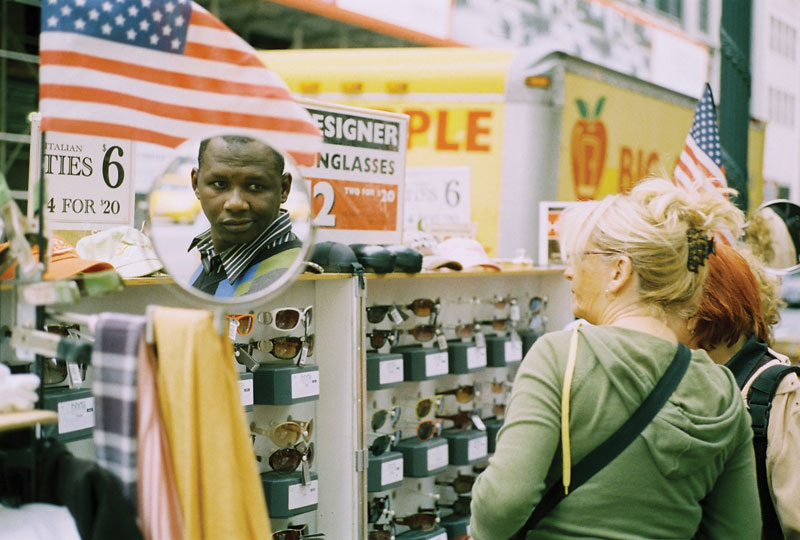Selected Lens Caps
Photographs by Thomas Sayers Ellis
Stare. It is the way to educate your eye, and more.
—Walker Evans

View all of Thomas Sayers Ellis's photos
The picture and the ballad are alike, if not equally social forces.
—Frederick Douglass
A shutter can be such a ghost house. I never met the man in the mirror, nor did I ever see the real him. I felt him, focused and framed, lens and feeling. There wasn’t time to see, so he became seen, outside the New York Public Library. I would love to name him, but naming can be so tragic. It really can kill an image and an idea.
Seeing is never done, no matter how framed it becomes or housed by stanza. I use my photography to create and to challenge literacy, so often I probably search for characters from famous books or poems in my pictures. I would love to have provided photographs for a book like u.s. 1 by Muriel Rukeyser, or Blacks by Gwendolyn Brooks. The photograph of the man with the Psychic sign is probably an image-draft of a speaker from a poem that wants to write me, one of my inner folk reporters.
I met Miss Julie and experienced Miss Julie, but all I know about her is her name. The photograph was taken in Drew, Mississippi, during a ride through the Delta, where I came upon her in the very lively way that she appears in the photograph, signifying, sitting outside holding a beer can, alone. I asked her if I could photograph her and she posed for me, many unpublishable poses. Then the police came and, being older than they were, she read them their rights.
•
I see the men and women in my pictures as swimming shapes glued to time. I want to say that time is to photography as light is to painting, but that is not an exact truth. Light is time (in photography) and time is light in the universe. The subjects of the photographs swim in this belief, and if there is any universe (any amount of unknown) in the image, in any picture, it certainly cannot be framed or contained—well, not for long. The men and women in my photographs want to escape form. They want space.
I see black and white as the removal of things that age rapidly. I see it without my eyes. I hear in it and taste and touch in it. I am even surprised when I take photographs and the roll of film comes back in color. My camera-sense seems to be at odds with reality.
The Malcolm X photograph destroys the reality of where it was taken. It hangs everywhere in the same way that Alberto Korda’s photograph of Che Guevara always shows up when there is struggle. The photograph erases that information. It exists wherever there are meetings not happening. The table (not the photograph within the photograph) is the Power Object.
I am still teaching myself color, how to use it—in photography and poetry—in a way that’s my own. There is so much of it in the world that we take it for granted. Isn’t that the point of Frank O’Hara’s “of how terrible orange is” from “Why I Am Not a Painter”? I see black and white, but I experience color, and often a blurred photo seems more real to me than a perfectly focused one. A blurred color photo seems to be deciding if it wants to be prose or poetry.
Do I “represent” race? I do, and so do you. Everyone does, even those who profess its absence—especially them, the avoiders. One can either represent race or be represented by race. The aesthetic, cultural, emotional, and psychological aspects of race and the responses to them (and racism) are fascinating. Black poets (not the ones who “just happen to be Black”) have a whole body-book (not handbook) of technical devices as a result of race and struggle-aesthetics. We only break lines when _________ are listening, and when _________ are not listening we fix them.
In the future the word for image will be word and the word for word won’t be a word but just silence. This is already true in advertising, Concrete Poetry, and jealousy.
When I am taking photographs, I am a photographer who is upset with poetry. When I am writing, I am a beggar who wishes he could afford the company of a notebook or a lens. I am impoverished and extremely hungry, in every sense of those words.
•
A photograph mostly contains choices and actions that are not mine, ones that outnumber mine and ones that I’ve surrendered to—just like when writing a poem. But I am aiming for invisibility when I take a picture much more so than when writing a poem. I want to be seen when I write and seeing when I take photographs.
•
I wonder if it’s best to wait for one of Henri Cartier-Bresson’s “decisive moments” or to interrupt the photograph and, perhaps, aid in the development of one of its possible enjambments. Very few poets are able to interrupt themselves, their lines, without destroying the integrity of the idea, image, or lyric-walk. Most poets just leap or lean, lazily, on the linear. I also wonder about my eyes; how long, in wetness, they will last.
Thomas Sayers Ellis grew up in Washington, DC, and earned his MFA from Brown University. He is the author of Skin, Inc. (2013) and The Maverick Room (2005). He cofounded the Dark Room Collective in Cambridge, Massachusetts, and received a Whiting Award in 2005. Ellis has taught at Sarah Lawrence College, Case Western Reserve University, and Lesley University. He lives in Brooklyn, New York.


